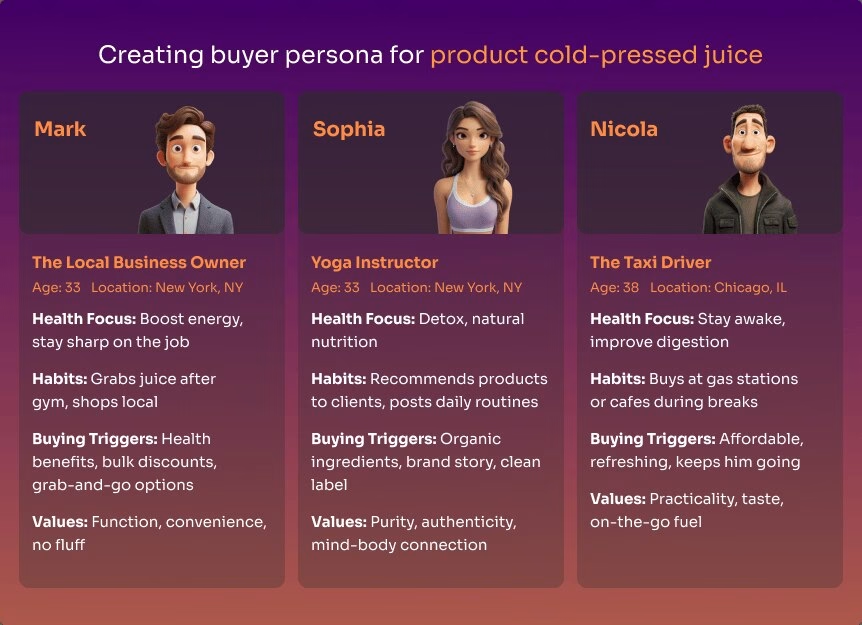
To quote a prominent, maybe the most important marketing author of the century, Seth Godin: “Marketing is no longer about the stuff you make, but about the stories you tell.”
This idea depicts why knowing who you’re talking to matters now more than ever. When you understand your audience, you are able to send messages that connect and inspire action. That is precisely what a buyer persona in digital marketing helps you accomplish. It’s a clear picture of your ideal customer based on real and accurate information.
If you want your efforts to reach the right people and bring real results, creating a well-defined buyer persona is a great place to start. In this blog post, we will go in detail through how to design a buyer persona that works for your business. After reading, you will be equipped with how to gather the right data, what details matter, and how to use the persona you created to make smarter and more efficient marketing decisions.
What Is a Buyer Persona And Why It Matters In Digital Marketing

A buyer persona is an in-depth representation of a fictional person who embodies your perfect customer. The profile of a buyer persona is all about its motivations, habits, challenges, and what influences their decisions. Instead of guessing, a buyer persona gives you a clear idea of your audience’s needs.
When it comes to digital marketing, where the end goal is to connect and sell, a buyer persona helps you write for someone instead of everyone. Also, nearly every decision in digital marketing, from the tone of your social media posts to the structure of your email campaigns, works better when it’s based on who you’re actually trying to reach.
Think of a buyer persona as the foundation of every message you send out.
Difference Between a Target Audience and a Buyer Persona
The target audience is a broad group, whereas a buyer persona is a specific character within that group. For example, working moms in their 30s who live in urban areas are a target audience, and a buyer persona would be Mila, 32, a marketing manager and mother of two, who loves reading product reviews and shops via mobile device.
Personas add depth and emotional context, while a target audience tells you only who you will market your product for. A buyer persona explains the reasons behind their purchasing decisions.
Don’t Miss These Key Elements of an Effective Buyer Persona

A well-rounded buyer persona includes more than just basic facts. To be useful, a buyer persona should cover several important areas:
Demographics
Always start with the basics, such as age, gender, location, education, and income. These details help you understand the general background of your audience.
Psychographics
As important as demographics, psychographics cover interests, values, lifestyle, and goals. Questions such as “What drives your audience?” and “What do they care about beyond my product or service?” should emerge when exploring and defining this segment of a buyer persona profile.
Behavioral Traits
What are their buying habits, how do they behave when shopping, when do they buy, and what triggers them to buy? What devices and channels do they get information from, and do they research a lot or make impulsive buying decisions?
Pain Points and Challenges
When you know what problems your customers and audience face, you are a few steps closer to offering solutions that can truly benefit them. Focus your research on what obstacles do they want to overcome the most.
Decision Triggers
What makes them choose one brand over another, and are there doubts and concerns that might hold them back from making a decision?
Preferred Content
What types of content do they engage with the most, and where do they go for information first?
How Buyer Personas Make Your Marketing Actually Work
When you truly understand what matters to your audience, your entire marketing approach will become sharper and more effective. A detailed and insightful buyer persona will help you:
- Write content that speaks directly to your audience’s needs
- Choose platforms and formats they engage with and use
- Tackle problems and objections before they even arise
- Guide your audience smoothly toward a purchase
With all this information, what you can expect is more engagement, better results, and less time spent on trying things out until they work. Instead of guessing what your audience wants, you will have the clarity to create messages that feel relevant, timely, and trustworthy.
Whatever your next digital marketing move is, having a clear persona at the centre of your strategy helps you make decisions that produce relevant results.
How To Gather Data For Building a Well-Rounded Buyer Personas

First off, remember that the most effective buyer personas are built on facts, not assumptions, as real data gives clarity and direction.
Here are four key ways to gather useful and accurate insights about your audience:
1. Existing Customer Data
Look at what is already in front of you. Tools such as GA4, CRM systems, and email marketing platforms can reveal a lot of important information about your current customers and visitors. From these sources you can extract information on demographics, locations, devices, time on site, and content preferences. Look for patterns among your most engaged users, and especially among the ones that are already converted to customers.
2. Analyze Social Media Insights
Social media platforms offer a goldmine of relevant information. Audience analytics on Instagram can tell you a lot about the demographics of your audience, most active time on the platform, and content preferences. Comments, DMs, mentions, and collaborations. All of this can be a powerful resource when creating a perfect buyer persona.
3. Surveys and Interviews
If we were to go back to school, the best way to understand something would be to ask. Apply the same principle to your audience and buyer persona research. Employ surveys and interviews to learn about their goals, expectations, frustrations, and buying process. This will fuel the accuracy of your buyer persona and boost the potential of your marketing efforts.
4. Keep Your Eyes On Customer Feedback and Reviews
Everything that the customer says about your product or service could be helpful in identifying recurring pain points or objections. These resources are especially relevant when you want to understand why people hesitate or what convinced them to act.
How to Create a Perfect Buyer Persona

Now that you have a clear grasp on what a buyer persona is and how to get the right data, it’s time to use that knowledge. We will now cover the steps you need to take to make a persona that represents your real audience and helps you reach your business and marketing goals.
1. Define Your Ideal Customer Profile
Before diving into the creation of fictional names and backstories, pause and assess your current customer base. Everything from who your top clients are, the ones who come back, recommend you to others, and contribute the most to your income.
This is where you want to be looking first, as these loyal, high-value customers are your starting point. They are the kind of people you would like to attract more of.
What you will be looking at:
- Who uses your product or services most frequently or extensively
- Who has the shortest buying cycle
- Who provides positive reviews or testimonials
- Who brings in the highest lifetime value
If you are just starting out and don’t have much or any customer data, look at your competitors – who are they targeting, what kind of audience are engaging with their content and offerings, etc. This means you have to do thorough competitor research beforehand.
The goal at this stage of creating a perfect buyer persona is to define the kind of customer you want more of, so every marketing effort that follows is built around attracting them.
2. Identify Patterns
After collecting all the relevant data and outlining your perfect buyer persona, the next step is to look at trends. Understand that you are not just focusing on a single person but uncovering common characteristics among groups of individuals who engage with your brand in similar ways.
As you review the collected data, begin to ask questions that uncover common themes. Are there job titles or industries that show up more often? Do your most loyal customers tend to fall within a specific age range or live in certain locations? Pay attention to challenges or goals that come up repeatedly in surveys or interviews, and notice which types of content or product features consistently attract their attention. These patterns will help you group similar customers together and form the basis for distinct, meaningful personas.
3. Segment Your Audience
After the research, you may find that your audience falls into several distinct groups. Consider groups such as small business owners, freelancers, creatives, and corporate marketing managers. Each group will have different needs, pain points, and buying triggers. This is where segmentation comes in.
You don’t need dozens of personas, but you need enough to reflect meaningful differences in your audience. Start small, with one or two segments, and build from there. Now you can create personas that give your strategy direction and help every campaign perform with purpose.
Now, It’s Time to Create Your Buyer Persona

Now comes the part where everything starts to click: turning your research into an actual person. Give your persona a name, a job title, and maybe even a short story about who they are and what a typical day looks like.
It might feel a bit awkward at first, like you’re inventing a fictional character, but it’s the best way to truly understand your audience. When you’re writing content or planning a Google Ads campaign, it’s much easier to focus when you’re thinking of a specific person instead of a vague group.
Include the basics you’ve gathered, such as their age, education, industry, and maybe income level, if that matters for your offer. Then try to go a little deeper. What’s stressing them out at work? What are they trying to achieve? What’s stopping them from getting there?
Also think about how they behave. Where do they go when they need help or information? Are they googling, watching TikToks, or asking around on LinkedIn? Do they shop carefully or make impulsive decisions?
You’re not aiming for a perfect portrait or the most relatable person for your product or service. The goal is to build something clear and specific enough to guide your marketing initiatives but flexible enough to adjust as you learn more (collect more data through analytics).
Avoid These Common Mistakes When Creating A Buyer Persona
Even though it’s not that complicated, it’s surprisingly easy to get off track when creating a buyer persona. It happens; you create a persona that sounds great on paper but doesn’t actually work.
Here are a few mistakes to watch out for so your buyer persona is helpful and not just something you check off the task list:
Research, Don’t Guess
Don’t assume you know your audience, especially if this is not your first rodeo. Skipping the research often leads to unclear or unrealistic personas that don’t actually reflect how people think or behave.
Don’t Make Too Many Personas
By making five or six personas, you and your team won’t know which one to focus on, and this may lead to more confusion when creating messages. Start with one or two that represent your most valuable customers, and build from there. More isn’t always better.
Don’t Focus Only on Basic Facts
While factors such as age and job title can provide some insight, they fall short of revealing the real reasons behind buying something. The real value comes from understanding their goals, frustrations, and how they make decisions.
Don’t Let Your Personas Collect
As individuals evolve in their routines, it’s essential for your enterprise to adapt as well. Take some time to periodically review your personas to ensure they remain relevant and effective.
A well-crafted buyer persona can guide you in making informed decisions in the real world. If something seems lacking or unclear, it’s likely worth revisiting.
How to Use Buyer Personas in Your Digital Marketing Strategy

Once you have your buyer persona ready, it’s time to actually employ and use it.
Buyer persona should shape the way you speak, what you create, and where you show up. When you know who you are talking to, it’s easier to craft messages that will come through to the right audience.
Here’s how you can use the buyer persona you have created in your digital marketing efforts.
Content Creation
Understanding your audience’s interests makes it much easier to generate ideas for engaging content, whether it’s articles, social media updates, or videos that resonate with them. Creating a well-defined persona guides you in consistently selecting the appropriate tone, format, and message for your writing.
Ad Targeting
By honing in on particular interests, behaviours, and platforms that align with your ideal customer, you can ensure that your resources are spent wisely, steering clear of those who were unlikely to engage in the first place.
Email Marketing
Write emails that resonate with an individual’s current stage in their decision-making process. Adding a personal touch often results in improved open and click rates. You will get better results when you know who you are talking to.
Website Experience
Your target audience can shape the way you showcase your offerings, from the main page to specific landing pages. This will help you focus on what matters to your target audience.
Your digital marketing becomes more focused, natural, and effective when you apply your buyer persona consistently across all channels.
Buyer Personas in Action: Real Examples
It’s one thing to talk about buyer personas in theory, but seeing how they work in real situations can really bring the idea to life. The truth is, even a simple persona can help a business shift from generic messaging to something that feels personal and relevant. You don’t need a huge budget or a big team, just a clear picture of who you’re trying to reach and what matters to them.
Here are a few examples of how different types of businesses have used personas to improve their marketing and get better results.
B2B Example
A software company offering project management tools created a persona called “Operations Olivia,” a 40-year-old operations manager who needs clear reporting and task visibility across teams. Based on that profile, they simplified their website messaging, added use-case content, and built targeted LinkedIn ads.
Ecommerce Example
An online skincare brand identified two key personas: “Ingredient-Conscious Emma” and “Quick-Fix Jake.” They used these profiles to write separate product descriptions, create email flows based on browsing behaviours, and customise ads. This helped reduce cart abandonment and improve product reviews.
Local Services Example
A home cleaning service realised most of their high-value customers were busy parents working full time. Their persona, “Weekend-Stretched Ana,” helped them refocus their blog, update ad visuals to reflect family life, and adjust their service hours.
Personas don’t need to be complicated. They should be useful enough to help you focus on who you’re really talking to.
Final Thoughts
The way we connect with customers has changed a lot. Years ago, broad messaging and a one-size-fits-all approach might have been enough. But today, people expect more. They want to feel seen, understood, and spoken to directly.
Buyer persona is a way to stay grounded in real people, especially when everything around us is moving fast: new platforms, shifting behaviours, and different expectations. At Ginger IT Solutions, we’ve learnt that even a well-thought-out persona can completely change the way a campaign performs. It brings clarity to your messaging, helps avoid unnecessary guesswork, and makes the work feel more purposeful for both your team and the people you’re trying to reach.

